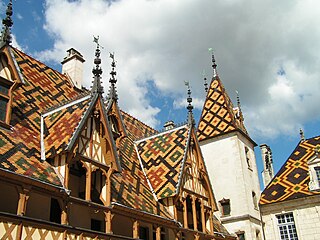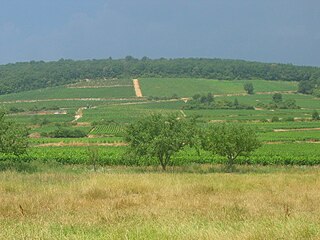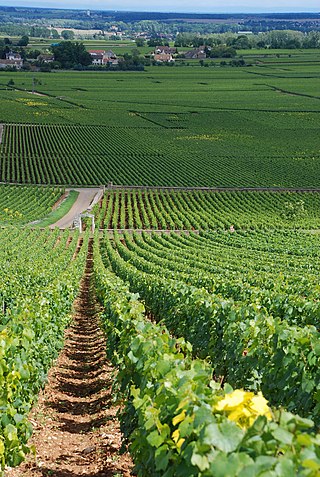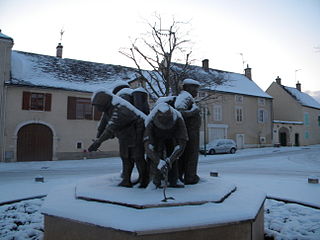
Côte-d'Or is a département in the Bourgogne-Franche-Comté region of Northeastern France. In 2019, it had a population of 534,124. Its prefecture is Dijon and subprefectures are Beaune and Montbard.

Beaune is the wine capital of Burgundy in the Côte d'Or department in eastern France. It is located between Lyon and Dijon. Beaune is one of the key wine centers in France, and the center of Burgundy wine production and business. The annual wine auction of the Hospices de Beaune is the primary wine auction in France.

Burgundy wine is made in the Burgundy region of eastern France, in the valleys and slopes west of the Saône, a tributary of the Rhône. The most famous wines produced here, and those commonly referred to as "Burgundies," are dry red wines made from pinot noir grapes and white wines made from chardonnay grapes.

Clos de Vougeot, also known as Clos Vougeot, is a wall-enclosed vineyard, a clos, in the Burgundy wine region, and an Appellation d'origine contrôlée (AOC) for red wine from this vineyard. It was named for the River Vouge, which is in fact only a stream separating the village Vougeot from Chambolle-Musigny. At 50.6 hectares, Clos de Vougeot is the largest single vineyard in Côte de Nuits entitled to the grand cru designation, while Corton in Côte de Beaune is the largest grand cru in Burgundy as a whole.

Corton is an Appellation d'origine contrôlée (AOC) and Grand Cru vineyard for red and white wine in Côte de Beaune subregion of Burgundy. It is located on a hill shared between the three villages of Aloxe-Corton, Pernand-Vergelesses and Ladoix in the Côte de Beaune, Burgundy. The appellation covers the lower parts of the Corton hill and includes several subordinate vineyard names, or climats, within the AOC. Because of the size of the AOC and the variability of these climats, it is the rule rather than the exception that the name of the climat is indicated together with that of the Corton AOC, leading to designations such as Corton Clos du Roi and Corton Les Bressandes. Corton is rare in this aspect, as the 'climat' is seldom used for other Grand Cru appellations in Côte d'Or. The AOC was created in 1937.

Nuits-Saint-Georges is a commune in the arrondissement of Beaune of the Côte-d'Or department in the Bourgogne-Franche-Comté region in Eastern France. In 2019, it had a population of 5,362.

The Côte d'Or is a limestone escarpment in Burgundy, France of the same name of the department which was formed around it. It stretches from Dijon in the north to the river Dheune to the south, overlooking the valley of the Saône to the east.

For the restaurant, see Montrachet (restaurant)

The Côte de Nuits is a French wine region located in the northern part of the Côte d'Or, the limestone ridge that is at the heart of the Burgundy wine region. It extends from Dijon to just south of Nuits-Saint-Georges, which gives its name to the district and is the regional center. Though some white and rosé wines are produced in the region, the Côte de Nuits is most famous for reds made from pinot noir. The Côte de Nuits covers fourteen communes. Six produce grand cru wines, in the central district between Gevrey-Chambertin and Nuits-Saint-Georges, with four lesser villages either side. The Grand Crus of the Côte de Nuits are some of the smallest appellations in France, less than a hectare in the case of La Romanée.

The Côte de Beaune area is the southern part of the Côte d'Or, the limestone ridge that is home to the great names of Burgundy wine. The Côte de Beaune starts between Nuits-Saint-Georges and Beaune, and extends southwards for about 25 km to the river Dheune. The trend of producing red wines continues from the Côte de Nuits to the north, down through Beaune, although the wines become lighter and more perfumed. Farther south lie the great names of white Burgundy such as Meursault and Chassagne-Montrachet. The far south of the district sees a return to red wines in Santenay that continues across the Dheune into the Côte Chalonnaise. This mix of Pinot noir and Chardonnay grapes reflects geology in the southern Côte d'Or that is more variable than in the north.

Saisy is a commune in the Saône-et-Loire department in the region of Bourgogne-Franche-Comté in eastern France.

Santenay is a commune in the Côte-d'Or department in eastern France.

Pommard is a commune in the Côte-d'Or department and Bourgogne-Franche-Comté region of eastern France.

Maison Joseph Drouhin is a French wine producer based in Burgundy that was founded in 1880. The estate owns vineyards in Chablis, the Côte de Nuits, Côte de Beaune and Côte Chalonnaise, as well as in the Willamette Valley in Oregon. Drouhin is also one of the major négociants of Burgundy, and produces wines made from purchased grapes grown in different parts of Burgundy. Today both Maison Joseph Drouhin and Domaine Drouhin Oregon are owned and operated by the great-grandchildren of Joseph Drouhin.

Volnay is a commune in the Côte-d'Or department in eastern France.

Puligny-Montrachet is a commune in the Côte-d'Or department in eastern France.
Musigny, sometimes referred to as Le Musigny, is an Appellation d'origine contrôlée (AOC) and Grand Cru vineyard for red and white wine in Côte de Nuits of Burgundy. It is located within the commune of Chambolle-Musigny, to the south of the village itself. It borders on the Grand Cru Clos de Vougeot in the southeast, the Grand Cru Échezeaux in the south, and the Premier Cru Les Amoureuses in the northeast. The name is derived from a family de Musigny which is now extinct, but which held offices in the court of the Dukes of Burgundy from the 14th century. The AOC was created in 1936, but the borders of Musigny were previously set down legally in 1929.

Nuits-Saint-Georges wine is produced in the communes of Nuits-Saint-Georges and Premeaux-Prissey in the Côte de Nuits subregion of Burgundy. The Appellation d'origine contrôlée (AOC) Nuits-Saint-Georges may be used for red and white wine with respectively Pinot noir and Chardonnay as the main grape variety. The name of the appellation is sometimes written simply as Nuits, without the Saint-Georges part. The word "Nuits" has nothing to do with "nighttime" but comes from the Latin for walnuts, Nutium. The production of red wine dominates greatly, with around 97 per cent, and only around three per cent white wine. There are no Grand Cru vineyards within Nuits-Saint-Georges.

Gevrey-Chambertin wine is produced in the communes of Gevrey-Chambertin and Brochon in the Côte de Nuits subregion of Burgundy. The Appellation d'origine contrôlée (AOC) Gevrey-Chambertin may be used only for red wine with Pinot noir as the main grape variety. There are nine Grand Cru vineyards within the commune of Gevrey-Chambertin, Chambertin and eight others called Chambertin in combination with something else, such as Chapelle-Chambertin. While Gevrey-Chambertin also has several highly regarded Premier Cru vineyards, it has a particularly large amount of vineyards at the village level for a Côte de Nuits appellation. This is because the vineyards of the AOC stretch further to the east than in most neighbouring AOCs.

Domaine Faiveley is a wine producer in Burgundy, France situated in Nuits-Saint-Georges and established in 1825. Faiveley also runs a négociant business, but this activity is much smaller in volume than the wine production from their own vineyards.




















